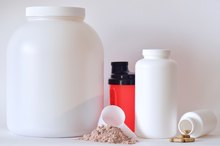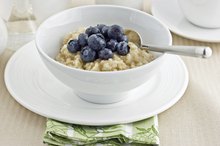What does fact checked mean?
At Healthfully, we strive to deliver objective content that is accurate and up-to-date. Our team periodically reviews articles in order to ensure content quality. The sources cited below consist of evidence from peer-reviewed journals, prominent medical organizations, academic associations, and government data.
- National Digestive Diseases Information Clearinghouse: Celiac Disease; September 2008
- Food and Drug Administration: Food Labeling Guide Appendix C – Health Claims; October 2009
The information contained on this site is for informational purposes only, and should not be used as a substitute for the advice of a professional health care provider. Please check with the appropriate physician regarding health questions and concerns. Although we strive to deliver accurate and up-to-date information, no guarantee to that effect is made.
Is Soy Protein Isolate Gluten Free?
Soybeans serve as an excellent source of protein. Unlike other plant-derived proteins, the protein found in soy contains all of the essential amino acids your body needs, classifying it as a complete protein. The U.S. Food and Drug Administration approved a health claim that states consuming 25 g of soy protein per day along with a low saturated fat and low cholesterol diet reduces your risk for heart disease. To add soy protein to a variety of food items, manufacturers produce soy protein isolate by removing the fat and carbohydrate from dry soybean flakes. Pure soy protein isolate is gluten-free 1.
What is Gluten?
Gluten is a mixture of two different proteins, gliadin and glutenin, found in wheat, rye and barley. Derived from the Latin word "glue," it becomes sticky when mixed with water. It is the gluten in flour that makes dough sticky and stretchy and gives bread a chewy texture. Any food made from wheat, rye or barley contains gluten, including bread, pasta and cereals. Many processed foods contain ingredients derived from gluten, like bran, bouillon, cracker meal, mustard powder, malt and soy sauce.
- Gluten is a mixture of two different proteins, gliadin and glutenin, found in wheat, rye and barley.
Importance of Gluten
Does Rice Protein Contain Gluten?
Learn More
Approximately one out of every 133 people in the United States suffers from a condition known as celiac disease, or gluten intolerance 2. Although many people remain undiagnosed, gluten intolerance causes a variety of digestive disturbances ranging from mild bloating and abdominal cramps to chronic diarrhea, weight loss, fatigue and weakness. The only treatment for celiac disease is adopting a gluten-free diet 2. Since gluten damages the small intestines and causes the symptoms, removing gluten from your diet allows your intestines to heal and relieves your symptoms.
Gluten Free Diet
Adopting a gluten free diet can be difficult at first. It requires more than just removing bread and cereal from your diet. You must carefully read all food labels to ensure it does not contain any ingredients that may contain gluten. To meet your daily nutrient needs you should incorporate a variety of fresh fruits and vegetables into your gluten free diet. Soy foods, including soy protein isolate, soybeans, tofu, soy milk and soy yogurt do not contain gluten. Eating soy protein isolate serves as a good source of protein and other nutrients 1.
- Adopting a gluten free diet can be difficult at first.
- You must carefully read all food labels to ensure it does not contain any ingredients that may contain gluten.
Soy Protein Foods
Hydrogenated Soybean Oil Allergies
Learn More
Food manufacturers add soy protein isolate to a variety of foods to boost the protein content of that food. Foods that commonly contain soy protein isolate include breads, baked goods, power bars, cereals and sauces. Any of these food items may also contain gluten, due the other ingredients, not due to the soy protein isolate. If you suffer from celiac disease check all food labels of foods that contain soy protein isolate 2. Pure soy protein isolate consists only of 90 to 95 percent soy protein with nutrients including calcium, potassium, phosphorus and folate.
- Food manufacturers add soy protein isolate to a variety of foods to boost the protein content of that food.
- Pure soy protein isolate consists only of 90 to 95 percent soy protein with nutrients including calcium, potassium, phosphorus and folate.
Related Articles
References
- Soyfoods Association of North America: Soy Protein Isolate
- Food Reactions: Celiac Disease and Gluten
- Ye, E. Q., Chacko, S. A., Chou, E. L., Kugizaki, M., & Liu, S. (2012). Greater whole-grain intake is associated with lower risk of type 2 diabetes, cardiovascular disease, and weight gain. The Journal of Nutrition, 142(7), 1304-1313.
- Bizzaro, N., Tozzoli, R., Villalta, D., Fabris, M., & Tonutti, E. (2012). Cutting-edge issues in celiac disease and in gluten intolerance. Clinical Reviews in Allergy & Immunology, 42(3), 279-287.
Writer Bio
Stephanie Chandler is a freelance writer whose master's degree in biomedical science and over 15 years experience in the scientific and pharmaceutical professions provide her with the knowledge to contribute to health topics. Chandler has been writing for corporations and small businesses since 1991. In addition to writing scientific papers and procedures, her articles are published on Overstock.com and other websites.









